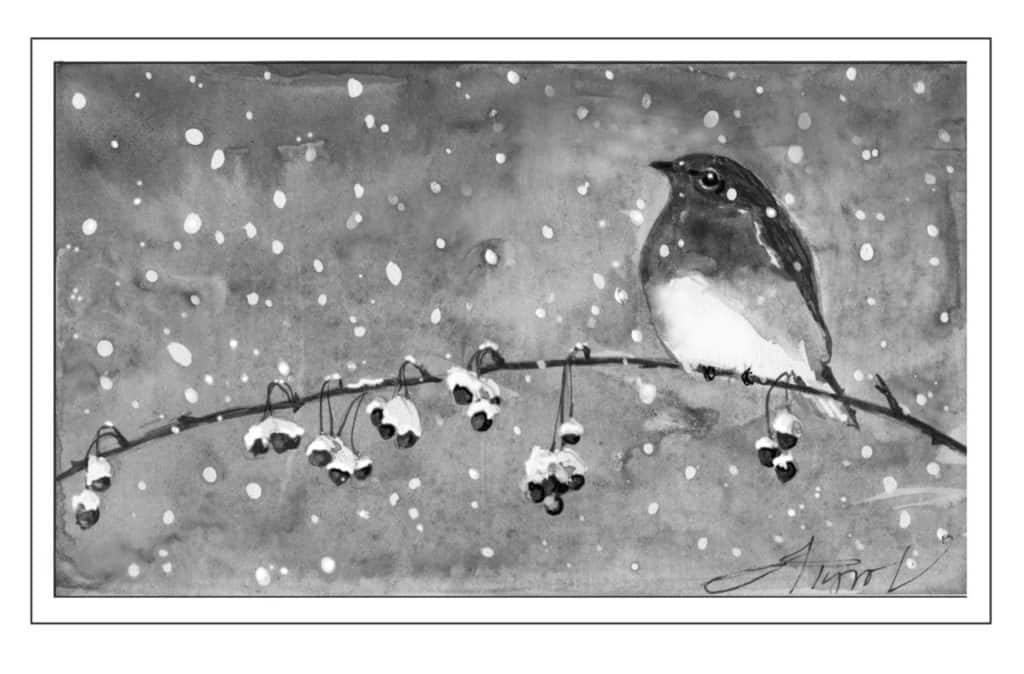
By Lee Emmons
On Valentine’s Day, as I sat down to write, I noticed a burst of blue outside my upstairs window. Looking out with my binoculars, I counted six eastern bluebirds. Clustered on and below my suet feeders, they were a wonderfully pleasant surprise on a chilly February morning. As I watched, the bluebirds briefly fed on the suet before finding perches in a red maple above the feeders. Within a few moments, they were gone entirely, an ephemeral splash of color amidst a snow-covered Maine lawn.
With their vibrant colors, bluebirds are easy to identify. Males sport a rich blue head and back with a rust-colored breast. In contrast, females are gray-blue with lighter breast coloration. The birds have small, round bodies, dark eyes, and a short bill. Bluebirds usually weigh about an ounce and are anywhere from 6 to 8 inches long.
Eastern bluebirds can be found throughout northern New England and parts of southern Canada during the breeding season. Historically, birds breeding in these regions have wintered in the southeastern United States and Mexico, but their year-round range has been shifting toward the north in recent years. The year-round population now extends from Central America to as far north as parts of New York, New Hampshire, Vermont, and Maine. Once a harbinger of spring, eastern bluebirds may eventually reside in the north woods throughout the year.
Flocks of bluebirds travel together during the cold-weather months seeking both natural and supplemental sources of food and will feed on a variety of wild fruits including sumac, winterberry, poison ivy, and wild grape. At feeders, bluebirds will consume suet, mealworms, and certain fruits. According to ornithologist Stephen W. Kress in his book “The Audubon Society Guide to Attracting Birds,” eastern bluebirds may eat raisins and currants placed “on a conspicuous surface such as a flat rock or table feeder.”
During the spring and summer, eastern bluebirds primarily eat insects, including crickets, caterpillars, beetles, and grasshoppers. Bluebirds also eat snails and spiders and may even consume lizards and small amphibians on rare occasions. Feeding typically occurs on or near the ground, but bluebirds can take insects in the air as well. They eat natural fruits in the trees or shrubs found in preferred habitats.
In the Northeast and elsewhere, eastern bluebirds live in open areas such as orchards, fields, parks, rural backyards, golf courses, and farms. Favored nesting sites include tree cavities, previously excavated woodpecker holes, and nest boxes of suitable size. Inside the cavity, the female bluebird constructs a nest of grass and other items. Bluebirds may have up to three broods during the breeding season, as local conditions permit.
Although eastern bluebirds are currently thriving in much of the United States, the situation was not always so rosy. According to American Bird Conservancy, “Eastern bluebird populations plunged in the early 20th century, when non-native house sparrows and European starlings were introduced into the United States. Both of these invasive species are also cavity-nesters and much more aggressive than bluebirds, so they quickly took over suitable nest cavities and habitats.” Thankfully, increased public awareness and the proliferation of artificial nest boxes in the late 20th Century have given eastern bluebirds a boost.
The recovery of the species is a well-documented conservation success story. Once on the brink, the eastern bluebird has become relatively common in suitable habitat throughout its range. With a North American population currently estimated at 20 million, the future looks bright. However, continued habitat loss and pesticide-related threats still pose dangers. To support bluebird conservation, bird watchers may install an appropriately sized nest box or leave local snags standing as natural nest sites.
A favorite of backyard bird watchers, bluebirds are a welcome sight at nature preserves and along roadsides. Like cardinals and orioles, these colorful birds seem to inspire much admiration, and the eastern bluebird is the state bird of both New York and Missouri.
I hope the bluebirds who visited my feeders in February will return soon. My suet feeders are stocked, and I’ve added raisins to the tray feeder. Even if they don’t pay me another visit, I appreciate the bluebirds’ sudden, colorful appearance during an ordinarily drab time of year.
Lee Emmons is a nature writer, public speaker, and educator. The illustration for this column is by Adelaide Murphy Tyrol. The Outside Story is assigned and edited by Northern Woodlands magazine and sponsored by the Wellborn Ecology Fund of the New Hampshire Charitable Foundation: nhcf.org.




